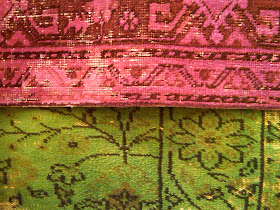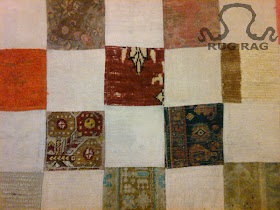Area rugs and carpet represent the ultimate flooring design statement. For that reason, I share with you an interview with David Dilmaghani, co-founder of RugRag.com, which specializes in traditional and decorative rugs and carpets, and an article he wrote for The Carpetology Blog about rug and carpet style inspiration.
C.B.: Dave, tell me about Rug Rag. How did the company get started?
DD: My brother Matthew and I co-founded the website RugRag.com in 2007. Rug Rag is a resource for those interested in learning about Oriental rugs, antique rugs, and area rugs. As the tech man for Rug Rag, Matthew has brought many of our interactive consumer widgets to life. With my specialty in hand knotted rugs, I author the vast majority of information in our Rug archive and on-site tools, and serve as a rug consultant for our readers and their questions on a daily basis.
One of the first tools we created was the Rug Estimator Pro: an interactive sampler tool to help consumers understand some determining factors which go into the assessment of new and used hand knotted carpets. Estimates rendered from this tool are actually derived from several thousand individually assessed and valued carpets from around the world, many of them from notable auctions and inventories of nationally recognized rug importers.
C.B.: How did you become interested in rugs?
DD: My brother and I come from a long line of history in Persian rugs, so it was natural for me to learn about them at a very young age. Many memories of our younger years consist of being surrounded by carpets at our father's rug showroom in New York. However, it was not until I reached my late teens that a true appreciation for this artisan craft quickly turned into a hobby, and then passion.
C.B.: So your passion for rugs, a marvelously tactile and visual product, led you to the online world. How did that happen?
DD: In the late 90s, I truly pursued my interests in rugs and started researching the subject. As with any research project, there's a very steep learning curve at the beginning. With rugs, the mystique of a fine rug often either intrigues an individual to know more or overwhelms them to the point of confusion. Additionally, a great deal of misinformation on rugs remains rampant online. In many instances, less reputable sellers continue to exploit first time buyer misconceptions with "sale" prices.
We saw a need for a reliable resource for rug information and launched Rug Rag. It's a destination for consumers to learn with us or, using easy-to-use tools and resources we've made available on our website, they can learn on their own. One example of this is our Oriental rug forum, which continues to be an excellent resource and unadulterated center for interacting with specialists in the field of Oriental rugs.
I spend much of my time attending rug auctions - this picture of me was taken at a recent Sotheby's auction - browsing carpets online and consulting with consumers about their carpets.
C.B.: Absolutely fascinating!
And now, here is the article that David Dilmaghani from RugRag.com shares with us about area rug and carpet style inspiration.
--------------------
There is little question that many years ago your interior designer would say timeless designs and classic motifs of reds and blues were the bread and butter of their business. Now, the new wave of area rugs is of an entirely different breed.
Contextually, area rugs are among the easiest and most versatile decorative items within a space. By mere definition, area rugs are movable. By exploiting this inherent characteristic comes clear benefit of freedom. Without question, it is an exciting time to be a consumer in this market as the carpets now available are clearly
aligned with this spirit of decorative freedom.
Centuries ago, it was not uncommon to find what we now call area rugs to be throws and cover-alls above the floor. Carefully draped atop tables and chair-backs of the elite and well-to-do, Post 18th century, area rugs (traditionally hand-knotted rugs) were introduced back onto floors. Not only was this an aesthetic movement, but also in part, to serve their intended utility. Although rugs have been made for many, many centuries with varying techniques, weaving styles and textures, specifically now what is being presented to the market are extraordinarily progressive, and perhaps exponentially more integrative area rugs. Revivals, new weaving styles, materials, motifs, and even artist statements are bringing this somewhat traditional market to an entirely new era of floor covering. With the onslaught of the internet, almost any permutation of an area rug floor covering can spread like wildfire.
As an ode to classic and traditional and classic designs (and a bit of shabby chic) with a twist of color come worn semi-antique Turkish carpets. Exhibiting wear pattern and strong overtones of post-production coloring, Color reform, as ABC calls their line of transformed art, makes new headway by rejuvenating otherwise deemed retired carpets.
Reinventing relics with brilliant, upbeat colors for a dazzled effect is what these whimsical carpets are all about. What a statement in how simple and effective use of color can bring entirely new emphasis on decorative value. Plus, they can be green. Literally and figuratively.
Old design adapted and reintroduced into the marketplace is not limited to Color Reform carpets. Patchwork rugs, perhaps many years ago seen as the “seersucker” of area rugs, are exploding within the marketplace – so much so they’re being woven in one piece as opposed to being sewn together. These sometimes mismatched and haphazard integration of snippet designs completely transcends traditionalism in many ways.
With few exceptions, hand knotted rugs have largely been unbranded for the past century. Samad, a renown importer of fine hand knotted carpets, literally brings art back to the floor with a new twist.
Examples such as the Rex Ray collection provides duality - the prestige of a Samad rug with additional decorative appeal from the work of San Francisco based graphic designer, Rex Ray. Beautifully rendered and expressive designs adapted within the age-old technique of a hand knotted, piled carpet.
Traditional Flokati shag, not entirely dissimilar to the thick piled carpets of the 60s and 70s, seemed to have risen back into the marketplace as a high contender in the 90s and early 2000s. However, it seems many forgot how frightening these types can potentially be to keep clean, let alone vacuuming. Newer developments include a thick pelted felt pile with fat, nubby pile. This translates into an entirely different visual effect, but more so, a completely new consumer experience AND sensation while walking on these unique area rugs.
Timeless and classic motifs of yesteryear continue to have heavy momentum within the new market of area rugs. Although the new market in area rugs is constantly evolving, often incorporating bits and pieces of the old (literally). In a highly interactive world, with constant changes and developments continuing to propel the area rug market forward there is no question that rugs are the best investment of choice: Adaptable decorative items within interior design in many cases, providing a tangible experience in home decor harnessing your
room, whether on the wall, table, or of course the floors.
------------
Thank you, David, for sharing this marvelous area rug and carpet style inspiration! Rugs truly are the ultimate in design statements and these examples you've shared with us are marvelous!
I'd love to hear reactions to these area rug styles. Which is your favorite? How do you see using such design statements in your home?
You can reach David Dilmaghani on www.RugRag.com, on Facebook or via email at info@rugrag.com.






No comments:
Post a Comment
Reminder: Please, no self-promotional or SPAM comments. Don't bother if you're simply trying to build inauthentic link juice. Finally, don't be anonymous: it's too hard to have a conversation. Thanks, CB